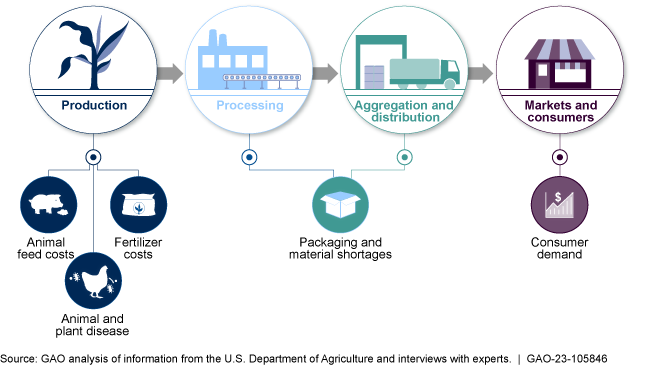Food Prices: Information on Trends, Factors, and Federal Roles
Fast Facts
From 2021-22, U.S. retail food prices rose by 11%—the largest annual increase in over 40 years. Rising food prices particularly impact low-income consumers, who spend about 30% of their income on food.
Many factors influencing the food supply chain can affect retail food prices, such as global trade issues, pandemics, animal and plant disease outbreaks, and war.
Federal agencies don't control food prices, but may indirectly affect them. For example, by relaxing regulations to let food made for restaurants be diverted to grocery stores, the FDA helped to avert food shortages that could've further increased prices during the COVID-19 pandemic.
Some Factors that Can Affect the Supply Chain and Contribute to Changes in Food Prices

Highlights
What GAO Found
From 2021 to 2022, retail food prices in the U.S.—the food prices consumers see at grocery and other food stores—rose 11 percent, the largest annual increase in over 40 years, according to the Bureau of Labor Statistics and U.S. Department of Agriculture (USDA). In contrast, retail food prices had generally increased by an average of 2 percent per year from 2013 to 2022.
Many factors that affect the food supply chain can affect retail food prices. Such factors include global trade issues, weather events and climate change, animal and plant disease, the COVID-19 pandemic, and the Russia-Ukraine conflict. It is difficult to determine the individual effect of any one factor on retail food prices, according to USDA officials and experts GAO interviewed.
Federal agencies' actions, such as their efforts to support the food supply chain, may indirectly affect retail food prices. For example, FDA responded to disruptions in the food supply chain by offering regulatory relief and other flexibilities that allowed producers to divert food made for consumption in restaurants to grocery stores. This action helped to avert shortages that could have further increased retail food prices during the COVID-19 pandemic, according to FDA officials. In addition, to help lower food costs amid supply chain disruptions, USDA provided funding to help meat and poultry processors expand their operations and for producers to expand fertilizer manufacturing. However, agencies do not have a direct role in controlling price increases, according to agency officials.
Why GAO Did This Study
Increases in food prices can pose a hardship for many in the U.S., particularly low-income consumers whose food expenditures comprise an average of 30 percent of their total income, according to USDA. Multiple factors along the food supply chain can affect the food prices consumers see at grocery and other food stores. Several federal agencies have programmatic and regulatory responsibilities aimed at supporting the food supply chain.
GAO was asked to examine factors affecting food prices. This report provides information on (1) retail food price trends from 2013 to 2022; (2) factors that may affect retail food prices; and (3) various roles the federal government may play in supporting the food supply chain. GAO summarized data on retail food prices for 2013 through 2022, analyzed academic literature and agency documents, and interviewed agency officials and experts. This report focuses on actions taken by the Departments of Agriculture, Commerce, Justice, Labor, and Transportation; the Environmental Protection Agency; the Federal Trade Commission; and the Food and Drug Administration.
For more information, contact Steve D. Morris at (202) 512-3841 or morriss@gao.gov.
